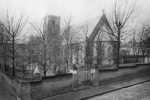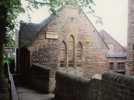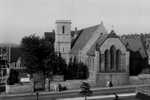For this church:    |
|
 Photograph of the church Photograph of the churchbefore the building of the chancel, showing an east-end apse |
Stevens had planned a thirteenth century Gothic-style church in Bulwell stone with green Westmorland slates. The Nottingham Journal claimed of St Paul’s in 1844 that the exterior was ‘marred by a lower tower of small dimensions, standing in the last bay but one, on the south-west side’, and that the church lacked a proper chancel (this was remedied in 1891). Inside the church the seats were ‘all low open benches with stall ends and including a small singing loft at the West End’. The church was 71 feet long and 34 feet broad, with an open timber roof 50 feet high. The reading desk and pulpit came from the old church at Lenton, which had recently closed - temporarily as it transpired - with the opening in 1842 of Holy Trinity.
In September 1844 a chapelry district was mapped out for St Paul’s. This was not, strictly speaking, a parish, but it was of much the same standing. The district was bounded by the River Leen in the north, Alfreton Road in the west, Sherwood Rise in the east, and the boundary of the Forest to the south. It included land from both Radford (92a 1r 26p) and Lenton (176a 3r 12p) parishes, a total of 269 acres. In March 1845 St Paul’s was given the right to publish banns of marriage and hold weddings.
In the 1851 census of religion (24 March 1851) there were 130 in the general congregation and 70 Sunday Scholars at the morning service. In the evening the congregation numbered 250. The vicar was satisfied that despite a late start, ‘the church has succeeded well in this neighbourhood’.
The first curate - later vicar - of St Paul’s, was the Rev Richard Blakeney, previously Browne’s curate at Lenton, but the living was very poor. Blakeney had neither a settled income (there was no endowment and no pew rents) nor a home. By late 1845 Browne was concerned that Blakeney would resign and the church would have to be closed. In the event sufficient grants were found for Blakeney to remain, although he resigned the living in 1852. Raising money in Hyson Green was not easy, but by early 1848 plans were in hand for a vicarage. A bazaar was held in the Low Pavement Assembly Rooms during January 1848 to raise money, and more than £300 was collected. This was not enough for work to begin, and by the time Blakeney resigned in 1852 no progress had been made.
The first permanent school, the Boy’s School, was erected in 1847-8 on glebe land donated by Browne. The boys’ school was extended in 1858-9, and a girls and infants school was opened in 1860. In 1912 665 children were on the Sunday School roll.
The first vicar had no house in which to live, and it was left to the second vicar, Rev David Carver to raise the money required. He persuaded Lord Middleton’s trustees to sell two closes of land amounting to about six acres, and awarded to the Willoughby family in 1799, on the best possible terms (to the church) for £149. Middleton had been awarded the two closes at the time of enclosure in 1799. These had not been developed. In 1853 Blakeney’s successor, Rev David Carver, persuaded the Middleton trustees to sell the land to the Ecclesiastical Commissioners, on what he described as the best possible terms, for £149. The Ecclesiastical Commissioners also made a grant of £300 towards building costs, and work began. The house was completed in 1855, and the Ecclesiastical Commissioners paid over the money in 1856, although they refused Carver’s request to provide a supplement because the house was costing more than anticipated. He asked, unsuccessfully, for a further grant in 1859 when money was still owing on the house.
The architect was S S Teulon, and the high church Ecclesiologist had mixed feelings about the building:
Mr Teulon has designed a new parsonage, for the district of St Paul’s, Hyson Green, which looks well for a moderate cost. We doubt however the effect of a somewhat Germanizing head which he has given to one of the doors, and must protest against a transom which occurs in a window with the central portion arched.
Carver lived in the vicarage until his death, still in office at the age of 80, in 1884. His successor, Rev John Birchall, regarded the house and grounds as inappropriately large for Hyson Green, and when he drew up plans in 1887 for extending St Paul’s Church he proposed to raise some of the finance by selling off the large garden fronting the vicarage. The Ecclesiastical Commissioners refused permission.
In a private survey of church attendance in December 1881, numbers totalled 102 at the morning service, and 170 in the evening. With over 400 spaces available the church was by no means full, and Hyson Green was, at the time, one of Nottingham’s fastest growing suburbs. In any case, Carver must have been struggling, since he was hardly the young man such an area perhaps needed. He died at the Vicarage in November 1884 of bronchial pneumonia, at the age of 80. He had been in post 32 years. The central east end window, with a picture of the Good Shepherd, was a memorial to Mr Carver, erected by subscription in 1890. By 1885 St Paul’s was described as containing a small west gallery and an organ (built by Lloyd).
An indication of the problems brought by the rapid expansion of Hyson Green came in 1880 when Carver requested help from the Ecclesiastical Commissioners for a larger burial ground: ‘The need for a burying ground is very great here. The population is becoming large - two hundred houses at least have been erected within these last two years.’ The St Paul’s burial ground was closed in 1882, with exceptions.
Rev John Birchall, who succeeded Carver, planned in 1889 an extension to the church, which was completed in 1890, and dedicated by the Bishop of Southwell on 25 September. The plan was to lengthen the building by adding a chancel, thereby creating about 200 extra sittings at a cost of approximately £800. Of this sum £200 was subscribed locally, and £180 was raised by a sale of work, but Birchall soon ran into similar problems to those which had afflicted his predecessors, Hyson Green `being a very poor district’, which had `suffered terribly for some time owing to the depression in the staple trades of this town’. Although some of the new housing currently being erected in the Forest Fields area was for better-off local people (’a few manufacturers, clerks and warehousemen’ in Birchall’s words) the majority were for artisans. Fund raising was a problem. After the extension the choir, which had previously not been robed and had sat in the gallery, moved to the chancel. The architect was Gilbert Doughty of Fletcher Gate.
When St Stephen’s Church, Bobbers Mill Road, opened in 1898, the parish of Hyson Green was split. As a result, the vicar of St Stephen’s lived on Burford Road, which was in the parish of St Paul’s, while St Paul’s vicarage lay within the boundaries of St Stephen’s. Birchall was unhappy with this arrangement and he proposed to the Ecclesiastical Commissioners in 1898 that they should sell the vicarage and buy land within the parish. Nothing was done immediately but land was obtained and a vicarage built c1902. Vicars of St Paul’s lived in the house until 1978. The old vicarage was sold into private hands, and for many years it was a doctors’ surgery.
In 1900-1 the PCC agreed to fund lighting by electricity. The cost, estimated at between £70 and £85, was to be met by holding a bazaar. This was organized for December 20-22 1900 and raised £98 19s 9d, of which £88 4s 6d was spent on the lighting. In 1905 a stained glass window was put into the church at the east end, side lights were added, and alterations made to the organ in memory of Joseph Billyeald, who died that year. Billyeald, a local lace manufacturer, had been superintendent of the Sunday Schools for fifty years from 1861, voluntary organist for thirty years, and churchwarden for twenty-five years.
The growing community in Hyson Green led to further initiatives, particularly the decision taken originally in 1903 to build a mission church on Forest Fields. The PCC agreed to approach Thomas Birkin to ask for a donation of land for a Mission Church on Sherwood Rise, but there the matter rested until Rev E Basil Roberts was instituted in 1907. Once again the proposal for a church on Sherwood Rise was put forward but without success, but in 1908 a proposal was put up for a church hall on Russell Road. In November 1910 it was finally agreed to go ahead with laying the foundations and St Simon’s Hall on Russell Road was dedicated in November 1911 and was supported by a curate. It was regarded as a memorial to the Rev John Birchall. An ante-room was built in 1914, and a further development was carried out in 1925 with the building of a wooden hut on adjoining land. This was sold in 1954 when alterations were made to St Simons. In 1979 St Simon’s was altered and refurbished as ‘The Family Centre’.
 Court
Street Mission Court
Street Mission |
In September 1912 St Paul’s bought an old Wesleyan chapel which they renamed Court Street Mission, which was supported by a curate. In 1913 a room at Court Street was altered for the Boy’s Brigade and an Institute. The Rev William John Parker established a Sunday School and Sunday evening service at St Simon’s, and started the new area of work on Court Street between 1914 and 1918. Subsequently in 1932 a mission church was built on Court Street, with donations from grocer JD Marsden and the John Player family. The Court Street mission was sold in 1951 as part of a parochial reorganisation.
Numerous alterations were made to the church during the twentieth century. A new holy table and reredos were provided in 1929, a screen and new doors in 1933, an electric carillon in 1928, and in 1969 an electric organ to replace the old pipe organ. The baptistry was altered in 1972 when pews at the rear of the church were removed. The Gregory Boulevard vicarage was sold in 1978 and a new house on Russell Road acquired. In 1982 the churchyard was improved with the removal of monuments.
 The
hall, just before its demolition The
hall, just before its demolition |
The school closed in 1930 and in 1947 the buildings were let as a community centre. In 1950 the PCC bought the original single storey schoolroom to create a new church hall and caretaker’s house. The double storey building was subsequently demolished to make way for a Salvation Army Housing Association scheme for self-contained flats.
By the 1980s Hyson Green could no longer support two Anglican churches. Communicant numbers at St Paul’s peaked in the years 1910-35, but declined thereafter. By the 1970s the area was changing with low density housing replacing many of the narrow streets originally laid out in the 1880s, as well as the building (and later demolition) of the notorious flats complex.
In 1984 St Paul’s was combined with St Stephen’s, Hyson Green, into a single ministry under The Rev Glyn Jones. Services at St Paul’s were discontinued in 1989, and the church closed in 1994.






